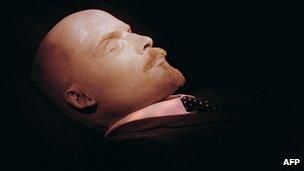Who, What, Why: How do you embalm a leader?
- Published

North Korean leader Kim Jong-il's body is expected to be embalmed and put on permanent display. How do you preserve a body indefinitely?
At the moment, the "Dear Leader's" body is on temporary display as it lies in state in the Kumsusan Mausoleum in Pyongyang. But there is already speculation that Kim Jong-il's body could undergo a long-term embalming process so that it can join his father's on permanent display in the mausoleum.
This has not been confirmed by North Korean officials, and some reports suggest he may simply be buried to save the cost of the long-term maintenance.

A photograph of Lenin released in 1991 showed a waxy-looking corpse
If it is preserved for the long-term, it will join Russia's Vladimir Lenin, China's Mao Zedong and Vietnam's Ho Chi Minh as former leaders whose bodies remain on display. Joseph Stalin's embalmed body once shared a spot with Lenin in a mausoleum in Moscow's Red Square, but it was moved to a tomb elsewhere in the 1960s.
It was Russian experts who are believed to have preserved Kim Jong-il's father Kim Il-sung. Since they prepared Lenin's body after his death in 1924, tales have told of revolutionary scientific techniques, secret preservation recipes, regular baths for the corpse and an electric pump being installed inside the body to regulate humidity.
Ilya Zbarsky, who was a member of Lenin's embalming maintenance team at the Research Institute for Biological Structures in Moscow, told the BBC in an interview in 1999: "Twice a week, we would soak the face and the hands with a special solution. We could also improve some minor defects. Once a year the mausoleum was closed and the body was immersed in a bath with this solution."
Such was the reputation of the Russians in the field of body preservation that Vietnam's former leader Ho's body was said to have been flown to experts in Moscow every year for a refresh.
So how would one prepare a body so that it will look unchanged for generations to come?
Embalming is the process of preserving the body from decay, and there are two approaches to the process, explains Karen Caney, national general secretary of the British Institute of Embalmers.
The most common approach, used by funeral directors, is to prepare a body so that it lasts until the body is buried.
"The embalming is designed to last literally until the time of the funeral. This is a fairly temporary preservation, so the body looks nice for the family."

The Ho Chi Minh Mausoleum holds the embalmed remains of Ho Chi Minh
What is known as light embalming is carried out. This delays the process of decomposition, preserving the body's tissues long enough for families to pay their last respects.
Embalming fluid - which typically contains the chemical formaldehyde - is diluted with water and injected into an artery, says Ms Caney.
"The sooner this is done the better, she says, as bodies start to alter from the moment someone dies."
After a few weeks, the body's internal bacteria takes over, but by then, the body will have been buried.
Most funeral directors are unlikely to have experience of long-term preservation.
Professor Sue Black, Centre for Anatomy and Human Identification College of Life Sciences at the University of Dundee, says that anatomy departments - in universities for example - are legally allowed to keep bodies for up to three years for students to work on.
"Fundamentally, the principle of embalming is like pickling - it's the same principle as food," she says. "To preserve a body for the long term, you would need to create a sterile environment."
Major vessels and veins are opened, blood is taken away - it can be a food source for bacteria - and the vascular system flushed with a particular solution.
"You have to completely change the chemical composition of the tissues, and get rid of all the bacteria, so that mould and fungus can't grow," says Prof Black.
A large volume of alcohol, glycerol - so you that the body doesn't dehydrate - and formalin, which kills everything off, is flushed around the body.
"Everything fixed, so it can't decompose - these are not very nice chemicals."
Prof Black explains that a pinkish tint is added to the formalin to give the body a realistic look.
"If you want to have a body permanently on display, you will have to address the external aesthetic - for example make up and a wig, because hair falls out."
To keep it in its best condition, you need to invest heavily, she says. Humidity and temperature need to be carefully controlled.
"For example, if a high level of alcohol is used, this can evaporate and the body can dry out, so a moist environment is needed. However you don't want to encourage mould, spores and fungus. And some flies, for example, can live on embalming fluids - so you need to 'keep the environment out and keep the environment in'."
Pictures of Lenin's body released a decade ago, show an illuminated body that looked waxy and strangely shiny. The embalming process, however, has moved on significantly since his original preservation.
"Embalming as an aesthetic has moved on in the past 20 years. But good embalming for long-term preservation is a dying art," says Prof Black.
She reckons the North Koreans will have easy access to the necessary products needed and the skills.
"The Chinese are very adept at anatomy and embalming - they are highly skilled and I think that will have found its way into North Korea."
But Prof Black warns that once it has been done, the body needs regular maintenance.
"When it dries out, you could immerse it for a few weeks to replenish the tissues," she says. "It will need to tended to like a plant on a fairly regular basis."
And then there are the outfits that need to be updated. According to one Russian embalming expert, interviewed in 2003, new clothes, including a trademark white spotted tie, are ordered for the founder of the Soviet state every three years.